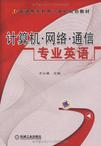计算机·网络·通信专业英语
出版时间:2009-2 出版社:机械工业出版社 作者:齐从谦 编 页数:279
Tag标签:无
前言
随着计算机、网络通信技术的飞速发展和日益普及,各行各业、越来越多的人每天都在与计算机、网络和通信打交道。然而,与计算机、网络和通信打交道时就免不了要使用英语,尤其是在登录国外的网站进行浏览和研究时,往往就需要具有一定程度的英语水平。高等工科院校三四年级的学生大都通过了国家四、六级英语考试,具备了较好的基础英语知识及听说能力,但是他们在掌握与本专业密切相关的英语词汇和阅读理解方面往往还有较大的欠缺。作者从自己多年的教学过程中了解到:这些学生在英文网站上阅读资料和信息时,或者在使用英文版的应用软件时,或者在撰写毕业论文的英文摘要时,都不是那么得心应手。因此,应该进一步加强“专业英语”的学习,多进行一些与专业有关的英语方面的训练,从而弥补上述不足。为此,面向高等工科院校计算机科学与技术、网络工程及通信工程等专业的师生,编写了本书。书中的内容大都取自美、英等国家最新出版的教科书、报刊杂志或在网上发表的有关计算机、网络及通信方面的文章,具有一定的代表性。
内容概要
本书从美、英等国家最新出版的教科书、报刊杂志或网络上发表的科技文章中精选了42篇在计算机、网络及通信等方面有代表性的文章,并进行了认真地分析和加工。文中特别注意了一些专业术语的英文表达形式以及它们的转义,对一些疑难的句子或语法现象进行了解释和注解。本书还通过练习进一步巩固所学的知识,帮助学生阅读和理解全文。 本书分为计算机科学与技术、网络及通信技术三大部分。每篇文章分为正文、词汇、注释、内容概述及练习五个模块。本书内容新颖了重点突出,特色鲜明,适合作为高等学校工科计算机科学与技术、网络工程、通信工程、电子信息工程、机电一体化及电子商务等专业的广大学生和教师的“专业英语”教学用书,也可以作为相关行业的广大工程技术人员的参考用书。
书籍目录
出版说明前言Part Ⅰ Computer 1.1 Computer Science(计算机科学) 1.2 Computer Systems History(计算机系统的历史) 1.3 Computer Architecture(计算机结构) 1.4 The Universal Serial Bus(通用串行总线) 1.5 An idealized Computer(一台理想化的计算机) 1.6 Microprocessor and Applications(微处理器及其应用) 1.7 0perating System Introduction(操作系统简介) 1.8 Computer Programming Language(计算机程序设计语言) 1.9 The Introduction ofPHP(PHP简介) 1.10 About MySQL(MySQL数据库简介) 1.11 Computer Simulation(计算机仿真) 1.12 Computerized Automation(计算机自动化) 1.13 Computer Vision(计算机视觉) 1.14 Computer Aided Design(计算机辅助设计) 1.15 Multimedia Technology(多媒体技术) 1.16 Bill Gates,Speech to Tsinghua University(比尔·盖兹在清华大学的讲话)Part Ⅱ Networks 2.1 The Basic of Computer Network(计算机网络基础) 2.2 The OSI Reference Model(开放系统互连参考模型) 2.3 TCP/IP(传输控制协渺网际协议) 2.4 Network Devices(网络设备) 2.5 Transmitting Media(传输介质) 2.6 IP Routing Protocols(IP路由选择协议) 2.7 Routed Protocol(被动路由协议) 2.8 How the Intemet Works(互联网工作原理) 2.9 Information Superhighway(信息高速公路) 2.10 The Ancient History of the Intemet(互联网史话) 2.11 A Brave New Web(奇妙的网络新世界) 2.12 Killer App ofthe Wired World(情有独钟的有线世界:网上购物) 2.13 Marketing Is Changing,Thanks to the Internet(营销起变化,缘于互联网) PartⅢ Communication 3.1 Introduction of Communication(通信简介) 3.2 Basic Knowledge of Communication(通信基础) 3.3 Introduction to Optical Fiber Communication(光纤通信简介) 3.4 Communication Satellite and GPS(通信卫星与全球定位系统) 3.5 0ptical Communication Technology(光通信技术) 3.6 Digital Certificates(数字证书) 3.7 Modulation and Encoding in Communication(通信中的调制和编码) 3.8 GSM Technology(全球移动通信系统技术) 3.9 The Principle and Components ofRadar(雷达工作原理及组件) 3.10 Type and Applications of Radar(雷达的种类及应用) 3.11 Video Conferencing Technologies(视频会议技术) 3.12 The E-Learning:Annotation(E-Learning:诠释) 3.13 The E-Learning:Review(E-Learning:述评)Appendix(附录)Appendix A The Terms and Abbreviations for Computer and Network Communication(附录A 计算机、网络与通信常用术语及缩略语)Appendix B Reference Answers(附录B 练习题参考答案)
章节摘录
USB supports four kinds of frames: control, isochronous, bulk, and interrupt. Control frames are used to configure devices, give them commands, and inquire about their status. Isochronous frames are for real-time devices such as microphones, loudspeakers, and telephones that need to send or accept data at precise time intervals. They have a highly-predictable delay but provide no retransmissions in the event of errors. Bulk frames are for large transfers to or from devices with no real-time requirements such as printers. Finally, interrupt frames are needed because USB does not support interrupts. For example, instead of having the keyboard cause an interrupt whenever a key is struck, the operating system can poll it every 50 ms to collect any pending keystrokes.A frame consists of one or more packets, possibly some in each direction. Four kinds of packets exist: token, data, handshake, and special. Token packets are from the root to a device and are for system control. The SOF. IN, and OUT packets in Fig. 1 - 11 are token packets. The SOF packet is the first one in each frame and marks the beginning of the frame. If there is no work to do, the SOF packet is the only one in the frame. The IN token packet is a poll, asking the device to return certain data. Fields in the IN packet tell which bit pipe is being polled so the device knows which data to return ( if it has multiple streams). The OUT token packet announces that data for the device will follow. A fourth type of token packet, SETUP ( not shown in the figure), in used for configuration.Besides the token packet, three other kinds exist. These are DATA (used to transmit up 64 bytes of information either way ), handshake, and special packets. The format of a data packet is shown in Fig. 1 - 11. It consists of an 8-bit synchronization field, an 8-bit packet type (PID), the payload, and a 16-bit CRC ( Cyclic Redundancy Code) 10 to detect errors. Three kinds of handshake packets are defined: ACK (the previous data packet was correctly received), NAK (a CRC error was detected ), and STALL(please wait-I am busy right now).11
编辑推荐
《计算机·网络·通信专业英语》是普通高等教育计算机规划教材之一。
图书封面
图书标签Tags
无
评论、评分、阅读与下载
用户评论 (总计4条)
- 就那样了 不适合自学
- 就像大学教材一样,一篇文章,一段单词积累,单词有点少,具体内容没看,书是新的
- 感觉书的质量很差,像盗版,内容看了一点,还不错。
- 帮别人买的 应该还不错!
